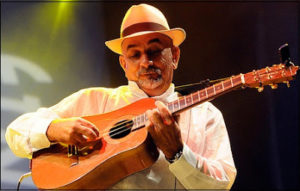 PANCHO AMAT “SUENA EL TRES” IN SPAIN.
PANCHO AMAT “SUENA EL TRES” IN SPAIN.
Pancho Amat, nicknamed “el tresero mayor de Cuba”, is on tour in Spain with his septet during this month of August.
Leonel Francisco Amat (Güira de Melena, Havana, 1950), popularly known as ‘Pancho Amat’, has played with Pablo Milanés, Silvio Rodríguez, Bebo Valdés, Joaquín Sabina and Santiago Auserón, among many others. He started playing the three at the beginning of the 70s and is one of the most outstanding treseros today.
With its Cabildo del Son project, which was born in 2000, it aims to offer an “updated vision of the Cuban son, but with bare roots”. To do this, they rely on authentic instruments such as the three, all the Cuban percussion -tumbbell, minor percussion instruments, clave-, guitar and trumpet.
“We use a format that has been in operation since 1927 and that Ignacio Piñeiro founded with the National Septet, as an institution,” he says.
This “rancidly Cuban” sound in his words, is based on rhythms from the East of the Island, and also from the West, from the traditional trova, rural music, some jazz and sonorities of classical music.
Amat, at the head of his Cabildo del Son group, “offers an up-to-date view of Cuban son where the musical tradition of the Island, jazz or classical, is mixed with the most contemporary sounds”.
The trensero shows that the common language helps to spread the son in Spain. “Having Spanish on our side allows us to highlight the work we do in Cuba and give it contemporary,” he says.
How it reaches the qualification of ‘tresero mayor’.
“My starting point was atypical: in my village where I learn to play the tres, I participated in the rumba ensembles, which were nothing more than percussion instruments and there I developed my rhythmic sense through the African polyrhythm”, remembers Amat, who He has studied in depth the tradition and styles of the son, to achieve the title of “tresero mayor de Cuba”.
Amat also collaborated with the groups of the Improvised Tenth: poets repentistas that make music at the moment in tenth format where the key instrument is the lute. “But if the lutenist was not going to play the role of the lute, it is the three and I tried to approach the language of the lute, which is a very fast instrument, designed for fast phrases, so when I started playing the three I had very present the speed of the lute and the rhythm of the drums, “he says.
Pancho Amat adds his own language to what the previous treseros such as Arsenio Rodríguez and Niño Rivera had already done and at the same time serves as a “transmitter pulley of tradition” for the new instrumentalists. “If there is an instrument that enjoys good health in Cuba today, it is the three,” he concludes.
 PANCHO AMAT “SUENA” EL TRES EN ESPAÑA.
PANCHO AMAT “SUENA” EL TRES EN ESPAÑA.
Pancho Amat, apodado “el tresero mayor de Cuba”, se encuentra de gira en España con su septeto durante este mes de agosto.
Leonel Francisco Amat (Güira de Melena, La Habana, 1950), conocido popularmente como ‘Pancho Amat’, ha tocado con Pablo Milanés, Silvio Rodríguez, Bebo Valdés, Joaquín Sabina o Santiago Auserón, entre muchos otros. Empezó a tocar el tres a principios de los años 70 y es uno de los treseros más destacados en la actualidad.
Con su proyecto Cabildo del Son, que nació en el año 2000, pretende ofrecer una “visión actualizada del son cubano, pero con las raíces desnudas”. Para ello, se apoyan en instrumentos auténticos como el tres, toda la percusión cubana —tumbadora, instrumentos de percusión menor, clave—, guitarra y trompeta.
“Usamos un formato que viene funcionando desde 1927 y que funda Ignacio Piñeiro con el Septeto Nacional, como institución”, apunta.
https://youtu.be/7QhEOFs5vLo
Esta sonoridad “ranciamente cubana” en sus palabras, se basa en ritmos del Oriente de la Isla, y también de Occidente, de la trova tradicional, la música rural, algo de jazzeo y sonoridades de la música clásica.
Amat, al frente de su grupo Cabildo del Son, “ofrece una visión actualizada del son cubano donde se mezcla la tradición musical de la Isla, el jazz o la clásica, con los sonidos más contemporáneos”.
El trensero pone de manifiesto que el idioma común ayuda a difundir el son en España. “Tener el castellano de nuestra parte nos permite poner de manifiesto el trabajo que nosotros hacemos en Cuba y darle contemporaneidad”, asegura.
Cómo alcanza el calificativo de ‘tresero mayor’.
“Mi punto de partida fue atípico. En mi pueblo donde aprendo a tocar el tres, participaba en los conjuntos de rumba, que eran instrumentos de percusión nada más y allí desarrollé mi sentido rítmico a través de la polirritmia africana”, rememora Amat, quien ha estudiado a fondo la tradición y los estilos del son, para alcanzar el título de “tresero mayor de Cuba”.
Amat también colaboraba con los grupos de la Décima Improvisada: poetas repentistas que hacen música al momento en formato décima donde el instrumento clave es el laúd. “Pero si el laudista no iba al que le tocaba hacer las veces del laud es el tres y yo trataba de acercarme al lenguaje del laúd que es un instrumento muy veloz, concebido para frases rápidas. Así que cuando empecé a tocar el tres tenía muy presente la rapidez del laúd y el ritmo de los tambores”, concreta.
Pancho Amat suma su lenguaje propio a lo que ya habían hecho los anteriores treseros como Arsenio Rodríguez o Niño Rivera y al mismo tiempo sirve de “polea transmisora de la tradición” para los nuevos instrumentistas. “Si hay un instrumento que goza hoy de buena salud en Cuba es el tres”, finaliza.
Agencies/ DDC/ Internet Photos/ Extractos/ YouTube/ Arnoldo Varona/ TheCubanHistory.com
THE CUBAN HISTORY, HOLLYWOOD.




